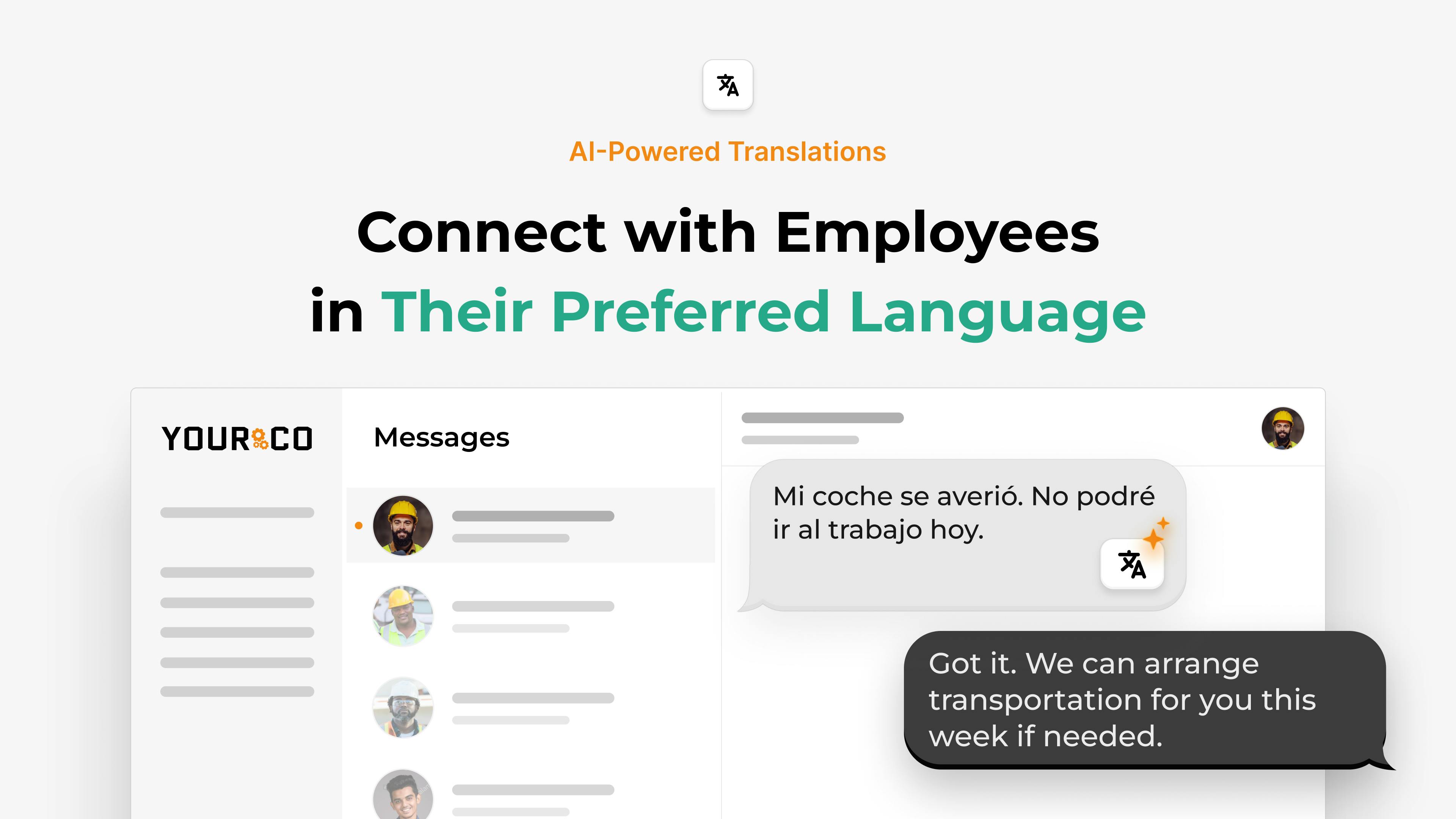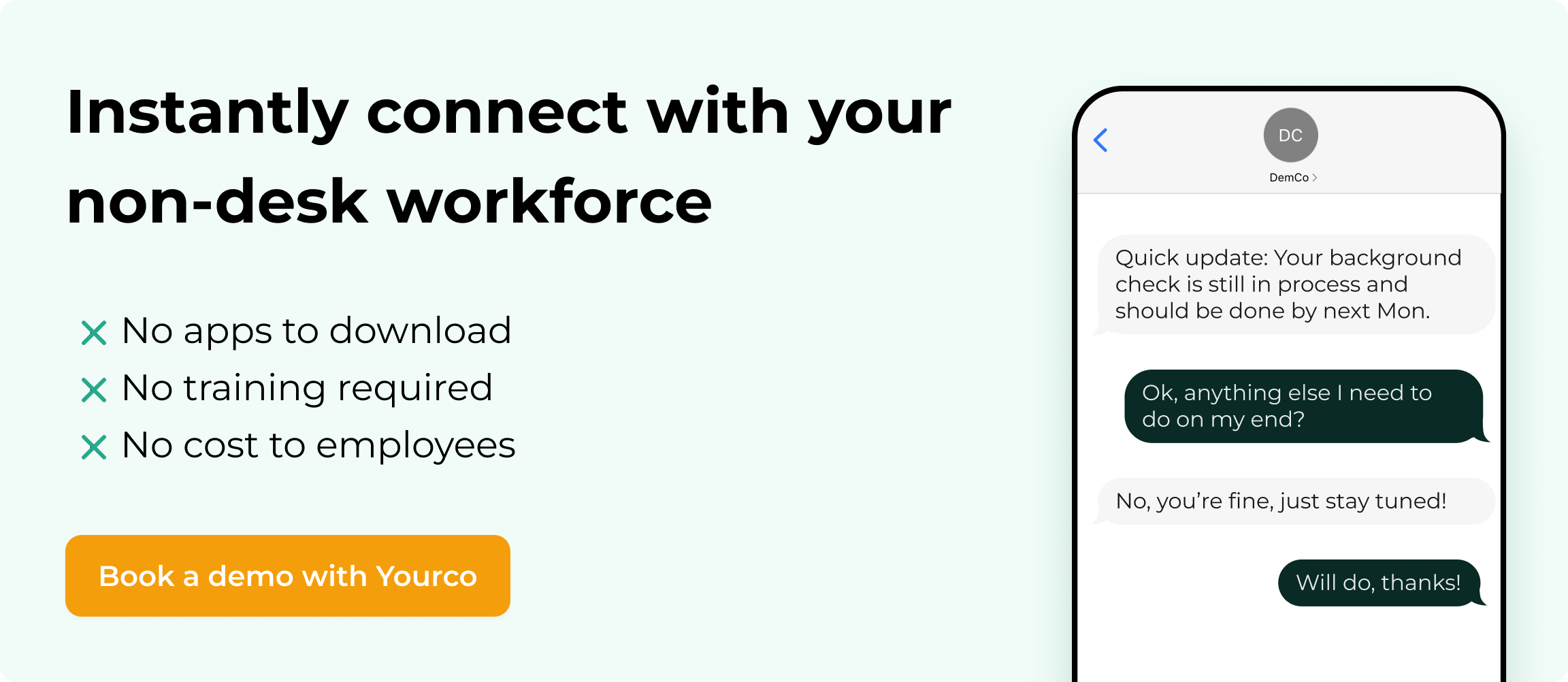How to Speak to Someone Who Doesn't Know English: A Practical Guide for Workplace Communication


In the United States, about one in five people speaks a language other than English at home, which means many teams include workers who may not fully understand instructions or training. But language barriers can slow down work, cause safety issues, and create frustration for both employees and managers.
Learning how to communicate with someone who doesn’t speak English is essential for building trust and keeping operations smooth. This guide shares simple, practical ways to bridge communication gaps, improve understanding, and make sure everyone on your team feels included and informed.
The Challenge of Cross-Language Communication in the Workplace
Today's workforce reflects an unprecedented level of linguistic diversity, with nearly one in five U.S. residents regularly speaking a language other than English at home. This diversity is particularly pronounced in industries like construction and manufacturing, where many employees may not speak English as their primary language. The implications are far-reaching, and language barriers can lead to misunderstandings that impact workplace safety and operational efficiency.
The challenge extends beyond safety concerns. As workplaces become increasingly diverse, fostering clear communication channels between English and non-English speaking employees has become a fundamental business imperative. Organizations must balance legal obligations, operational efficiency, and the creation of an inclusive environment while ensuring everyone is understood and valued.
5 Essential Communication Tools and Techniques
Modern workplaces need robust workplace translation tools to bridge language gaps effectively. When you use these tools right, they help create a more welcoming and productive workplace for everyone, no matter what language they speak.
Use Interpreters or Professional Translators
While an interpreter may not always be necessary, they provide exceptional value during lengthy meetings. For example, you might use an interpreter for onboarding or training non-English speaking employees where there's significant back-and-forth between employees and managers or trainers. These professionals seamlessly convey the message and meaning from a source language (in this case, English) to a target language. With interpreters, you can feel confident that your employees with limited English-speaking abilities understand exactly what you're saying in real time.
While interpreters use spoken communication, translators work with the written word. Professional translators convert written documents, like employee handbooks or training manuals, from one language to another. One advantage of using a professional translator is that they ensure the true meaning and intent of the message is conveyed, which helps overcome language barriers in the workplace. Typically, businesses work with translators on a freelance or project basis, reserving these services for the most important documents.
Use AI-Powered Translation Tools for Instant Communication
AI-powered translation technology enables instant communication across language barriers. With advancements in artificial intelligence, these tools can automatically translate messages in real time. By integrating AI in workplace communication, you allow employees to communicate seamlessly regardless of the languages they speak. Investing in translation software for business allows you to take advantage of AI-powered translation technology that eliminates delays and minimizes misunderstandings that can occur with manual translations.
Modern AI translation tools offer powerful capabilities that make cross-language communication simple and accurate:
- Context-aware language models reduce errors from slang, acronyms, or shift-related terminology that confuse generic translation tools.
- Automatic translations based on each employee's preferred language setting in the employee directory eliminate manual copy-pasting into Google Translate.
- Multilingual safety and compliance messaging ensures translated alerts, standard operating procedures, and policy updates reach every employee in their preferred language.
- Auto-translated policy acknowledgments include response logging for compliance, creating a clear audit trail while maintaining accessibility.
Leverage SMS Communication for Team Coordination
Using SMS communication with built-in translation features can enhance coordination across your team. Text messaging reaches employees directly on their phones, even basic flip phones, without requiring apps, downloads, or internet access. This approach is particularly valuable for distributing important updates and instructions in real time, sending training materials that require detailed explanations, and managing emergency communications requiring immediate understanding.
SMS delivers messages with high visibility rates. Around 98% of text messages are read overall, with approximately 95% read within the first 90 seconds, much faster than email. This ensures that vital information reaches every employee promptly, regardless of language barriers. Messages are delivered as individual SMS, not group threads, to avoid privacy issues and off-topic conversations while keeping replies private.
SMS-based communication provides essential benefits for multilingual teams:
- Individual message delivery avoids privacy issues and off-topic conversations, keeping all replies private between managers and employees.
- Two-way messaging allows local managers to have conversations with employees to answer questions and gather feedback.
- One-way broadcast channels let corporate teams send announcements where no response is needed.
- Real-time distribution of important updates, training materials, and emergency communications ensures immediate understanding across language barriers.
- Flexible communication tailored to each situation, whether you need dialogue or simply want to distribute information efficiently.
Add Visuals and Other Communication Tools
Visual communication tools are a great match for translation tech when you're trying to get complex info across. Using diagrams, pictures, and how-to videos really helps make sure everyone understands safety rules, how things work, and training materials.
When you're putting communication tools into action, begin with simple text translations for everyday chats, then add visual aids for more complex stuff. Taking a multi-tool approach makes sure that language differences don't get in the way of productivity or how happy employees are, all while keeping communication clear and accurate across your team. You can always bring in interpreters or translators when really important information needs to be discussed.
Best Practices for Clear Communication
When you communicate with non-English speaking employees, your approach can make the difference between genuine understanding and mere nodding along.
Adjust Your Speaking Style
Start by adjusting your speaking style. Speak at a moderate pace and use clear, simple language while avoiding idioms, jargon, or complex terminology. Pause frequently to allow time for processing, and pay attention to your listener's facial expressions and body language for signs of understanding or confusion.
Choose Your Words Carefully
Your word choice matters significantly. Break down complex ideas into smaller, manageable chunks. For example, rather than explaining an entire new process at once, break it into step-by-step instructions. When writing for AI-powered translation, use concrete terms instead of abstract concepts. "Next Monday at 9 AM" is clearer than "in the near future."
Use Non-Verbal Communication
Non-verbal communication plays a crucial role. Use gestures thoughtfully to support your words, but be aware that some gestures may have different meanings across cultures. Visual aids like diagrams, pictures, or demonstrations can transcend language barriers and enhance understanding, especially for technical or safety-related information.
Encourage Questions and Feedback
Effective communication is a two-way street. Encourage questions and feedback by creating a supportive environment where employees feel comfortable asking for clarification. When an employee seems hesitant, you might say, "Would you like me to explain that again?" rather than asking, "Do you understand?"
Involve Professional Translators for Critical Communications
For critical communications, such as safety protocols or disciplinary discussions, always involve a professional translator or bilingual staff member. This ensures both legal compliance and clear understanding. Have the translator sign any important documents and note their role in the communication process.
By implementing these practices consistently, you create an environment where all employees can fully participate and contribute, regardless of their English proficiency level.
Safety and Compliance Considerations
When managing non-English speaking employees, safety and compliance are legal requirements, not just best practices.
Comply with OSHA and EEOC Mandates
Both OSHA and the EEOC mandate that employers must provide training and safety instructions in languages their employees can understand. Simply having employees sign attendance sheets for English-only safety training when they don't fully comprehend the content puts both workers at risk and employers in legal jeopardy.
Take Steps to Ensure Safety and Compliance
To meet these requirements and ensure workplace safety, provide bilingual safety manuals and warning notices, ensure all safety training is conducted in employees' primary languages, use qualified interpreters during critical safety meetings, and document that employees truly understood the safety protocols, not just that they attended training.
SMS-based safety alerts can help you meet compliance requirements while ensuring message delivery. Employees can report incidents by texting photos and notes directly to the company number, creating timestamped documentation. HR and safety teams can reply directly via SMS to gather more details and follow up. This real-time incident reporting reduces delays and improves safety culture by making it simple for employees to take action and report concerns.
Understand the Consequences of Non-Compliance
If an accident occurs and OSHA investigates, they may interview employees to verify their understanding of safety protocols. If they discover that employees couldn't understand their training due to language barriers, your company could face significant penalties, regardless of signed attendance sheets.
Creating an Inclusive Workplace Environment
Building a linguistically diverse workplace involves creating an environment where every employee can thrive, not just accommodating different languages.
Foster Inclusivity Through Language Sensitivity
To foster inclusivity, start by recognizing that language has emotional resonance for your employees. When team members speak their native language during breaks or informal conversations, they're often seeking comfort rather than trying to exclude others. Create clear guidelines that balance operational needs with cultural sensitivity. For instance, use English for safety-critical communications while allowing native language use during social interactions.
Implement Diversity Training Programs
Organizations like Johns Hopkins Medical Institutions implement diversity training in every new-hire orientation and use personality indicators to help team members find common ground despite language differences. Their flexible approach focuses on similarities rather than differences, creating an environment of mutual understanding and respect.
Embrace Linguistic Diversity
Multilingual environments enrich our understanding of others and contribute to a more dynamic workplace. By embracing linguistic diversity, you're not just supporting your current workforce, you're positioning your organization for success in an increasingly global business landscape. Translation ensures all employees, regardless of language, receive and understand time-sensitive updates, reducing workplace inequity and fostering a culture where everyone can participate fully.
Implementing Effective Communication Strategies
Creating an inclusive communication environment requires systematic implementation and measurable results.
Assess and Address Communication Gaps
Start by assessing your current communication gaps and implementing professional translation services for critical documentation. Ensure your managers are equipped with proper cultural competency training and establish clear protocols for important conversations like safety briefings and performance reviews.
Leverage Technology for Consistent Communication
Successful communication strategies require consistent execution and regular evaluation. Modern technology solutions can streamline this process, automating translations and ensuring message delivery across language barriers. By implementing a comprehensive communication platform, you can transform language differences from obstacles into opportunities for greater workplace cohesion and productivity.
Communication platforms with built-in analytics help you track message delivery and responses, flagging undelivered messages so you can maintain accurate contact data. You can segment messages by location, role, or shift to ensure the right message reaches the right people. HR and site managers can message everyone in their preferred language without needing to segment by language group manually, simplifying multilingual communication workflows and saving time.
Simplify Cross-Language Communication with Yourco
Bridging language gaps doesn't have to be complicated. Yourco offers an intuitive SMS-based platform that translates messages into over 135 languages and dialects instantly using AI-powered translation. This means you can communicate important updates, safety protocols, and daily communications directly to your non-English speaking employees without requiring apps, downloads, or internet access.
With Yourco, you ensure that every team member stays informed and connected, enhancing safety and productivity across your organization. Here's how simple it is:
Sending Translated Messages:
- Go to Employee Directory and set each employee’s Preferred Language.
- Select "Message Employees".
- Choose the person, location, department, or group to message.
- Type your message, translation happens automatically.
- Click Send.
Receiving Translated Messages:
- Open the message you’ve received in the Yourco platform.
- The message is already translated into your preferred language.
- To view the original version, click the three dots at the bottom of the message and select “See original message.”
Yourco makes it easy for everyone, from managers and HR representatives to employees, to communicate via SMS text message. Every message is logged and timestamped, creating a searchable record for audits and compliance. The platform tracks delivery and responses, and confirms successful delivery so you know your messages reached their destination. Take the first step towards seamless communication and create an inclusive workplace where everyone can contribute confidently.
Ready to transform your workplace communication? Try Yourco for free today or schedule a demo and see the difference the right workplace communication solution can make in your company.
Frequently Asked Questions
How do you communicate with someone who doesn't speak English at work?
Communicate with non-English speaking employees by using simple, clear language, speaking at a moderate pace, and incorporating visual aids like diagrams or demonstrations. Leverage AI-powered translation tools for instant messaging, and consider professional interpreters for complex conversations like safety training or performance reviews. SMS-based platforms like Yourco, with built-in translation features, work particularly well because they reach employees directly on any phone without requiring apps or internet access. These platforms achieve around 98% read rates compared to just 20% for emails, ensuring critical information gets through.
Are employers required to provide translated safety training materials?
Yes. OSHA and the EEOC both state that training and safety instructions should be provided in a language employees can understand. Having workers sign attendance sheets for English-only sessions they do not actually understand can lead to compliance problems and serious safety risks. It is good practice for employers to make sure employees truly understand safety procedures, not just that they attended the training. During OSHA investigations, inspectors may ask employees to describe safety steps to confirm they understood the material.
How can I ensure non-English speaking employees understand important company announcements?
Ensure understanding by delivering announcements through multiple channels with translation support. Segment your messages by language preference, follow up with visual materials when appropriate, and enable two-way communication so employees can ask questions. For critical announcements, consider having bilingual team members available to answer questions and confirm understanding.
What are some effective ways to build trust with non-English speaking employees?
Building trust starts with consistent, respectful communication. Make an effort to learn a few basic words in your employees’ primary languages to show goodwill. Encourage feedback and take time to listen, even if it requires translation assistance. Recognize achievements publicly and make sure all employees have equal access to company updates, training, and opportunities. When workers feel heard and included, engagement and safety both improve.





